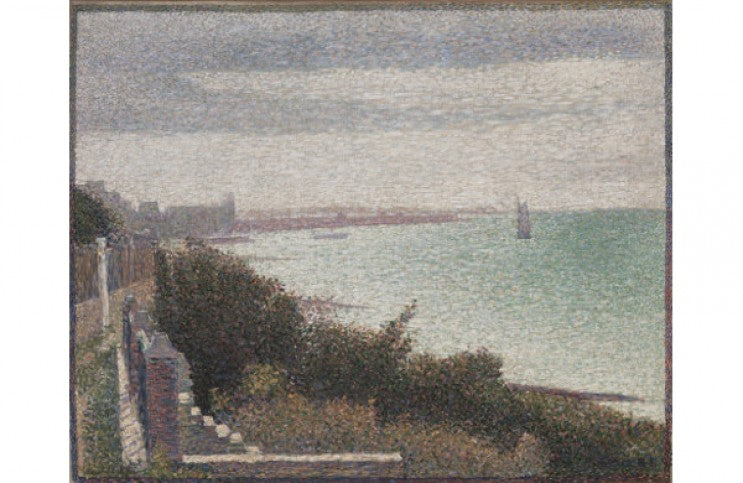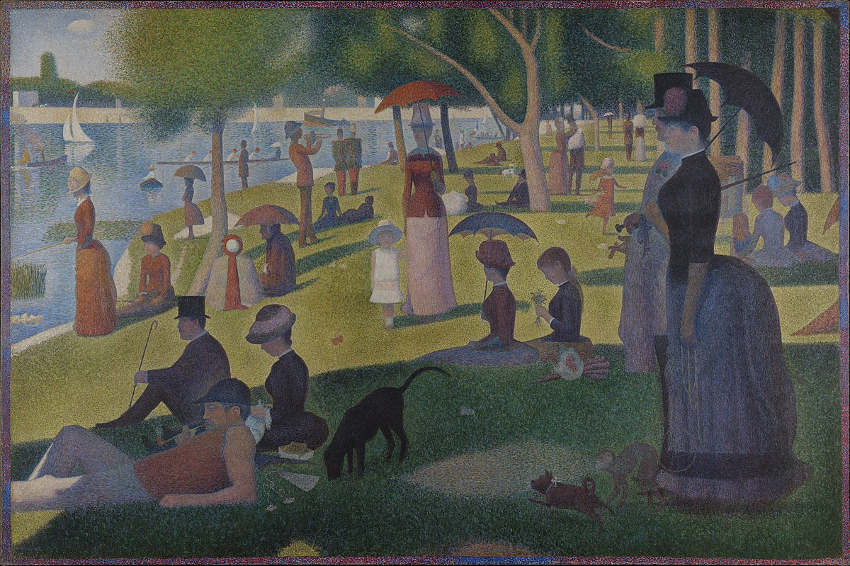
Divisionism and Its Influence on Color in Art
Divisionism was one of the most influential aesthetic developments of the 19th Century. It emerged out of the Post-Impressionist period, and is essentially a method of painting a picture in which the colors are not mixed ahead of time, but are rather placed beside each other on the surface so that they will later mix “in the eye.” The idea was first developed by Georges Seurat in 1884, the same artist who two years later would develop an aesthetic position called Pointillism. Most people are more familiar with Pointillism, since its name so clearly references the style—pictures composed of infinite tiny circles, or points. Pointillism and Divisionism are similar to each other. The main difference is that Pointillism is not necessarily based on the mixing of colors in the eye—it is simply a technique in which the picture is composed of dots instead of fluid brushstrokes. In a Pointillist picture, the image becomes more legible to the eyes as the viewer moves farther away from it and the dots blend together. The same principle is in play with a Divisionist painting, except it is not only the forms and figures that blend together as the viewer moves farther away, but also the colors. Divisionism challenged the nature of what color is, and questioned whether it truly exists as something concrete or whether it is merely a figment of our perception and imagination. The movement had a profound effect on the development of abstraction in late 19th and early 20th Century Europe, for multiple reasons. First, it plainly prioritized plastic elements like color over content. Second, it posed the question of subjectivity in art. Viewers “finish” Divisionist paintings in their minds, a notion that became the foundation for the idea of giving viewers autonomy to interpret works of art—especially abstract works of art—anyway they please. Finally, Seurat initiated an approach to art that involved overt scientific investigation. His interest in the science of color and perception has inspired generations of conceptual and abstract artists, and continues to exert a strong influence today.
Accidental Impressions
While Seurat is acknowledged as the founder of Divisionism, he was not actually the first painter to use the Divisionist technique. Earlier Impressionist painters like Camille Pissarro and Claude Monet had discovered decades earlier that they could achieve greater luminosity in their paintings by using small, tight brush strokes and by placing certain complimentary colors next to each other. What the Impressionists were doing, however, was more a matter of intuition. Seurat earned his reputation by analyzing what the Impressionists had done in a scientific manner. In search of a unique way of painting that could be considered all his own, he also went back farther to study the work of Romantic painter Eugène Delacroix, who was renowned for the brilliant and vivid colors of his canvases. He also read various books on color theory from the past, in particular The Grammar of Painting and Engraving (1867) by Charles Blanc, and The Principles of Harmony and Contrast of Colors (1839) by Michel-Eugène Chevreul.
Through his research, Seurat discovered that certain colors reacted more powerfully when placed next to each other than others. By honing the Impressionist technique of small brushstrokes down to its most precise execution, and by mobilizing the most active possible color combinations, he achieved something he called chromoluminosity—the ideal, luminous marriage of color and light. Perhaps the most famous painting to come out of his early studies into chromoluminosity is “Sunday Afternoon on the Island of La Grand Jatte” (1884-86). The masterpiece is a fantastic demonstration of the ability of Divisionist techniques to blend not only color in the eye, but also other formal elements like tone, form, and line. Most radically, Seurat achieved a sense of movement with this painting. The placement of the tiny colored dots makes the water seem to gleam and glow, and the waves seem to jiggle. The leaves in the trees seem to be rustling. Most oddly, the woman in the bottom right foreground seems to be hovering above the ground and gently moving forwards.

Georges Seurat - A Sunday Afternoon on the Island of La Grande Jatte, 1884–1886. Oil on canvas. 207.6 cm × 308 cm (81.7 in × 121.25 in). Art Institute of Chicago
Inspiration for the Future
Seurat was immediately recognized for his intellectual and aesthetic accomplishments, but he was not able to enjoy his success for long. He died at age 31, just five years after finishing “Sunday Afternoon on the Island of La Grand Jatte.” His legacy, however, far outweighed the brevity of his career. His ability to seemingly convey movement in his paintings proved to be a profound inspiration on the Italian Futurists. When the Futurist Manifesto was published in 1909, it praised speed and industry as ideal manifestations of the beautiful, new, modern, industrial world. The Futurists borrowed the ideas of Seurat to create their own signature style. Instead of only placing colors or points next to each other so that they could be blended in the eye, the Futurists expanded this concept and applied it to lines, shapes and forms. By painting multiple images of the same forms next to each other in their compositions, they implied the movement of machines, people and animals.
This same idea also influenced the Cubists. Artists like Picasso and Braque applied Divisionist thinking to planes, placing multiple simultaneous points of view next to each other to create a vision of four-dimensional reality, in which the passage of time and movement are implied. Later, Orphic Cubist painters like Sonia Delaunay brought Divisionist evolution back full circle again by exploring the ways certain colors seem to vibrate when placed next to each other, even when they are deployed in a completely abstract composition. This is perhaps the greatest legacy of Post-Impressionist movements like Divisionism when it comes to abstract art: thanks to the work of Seurat, artists like Delaunay, and later Piet Mondrian, Josef Albers and countless others were able to completely escape the demands of content and subject matter, and were free to explore the purely plastic properties of the visual arts.
Featured image: Georges Seurat - Grandcamp, Evening. 1885, painted border c. 1888-89. Oil on canvas. 26 x 32 1/2 in (66.2 x 82.4 cm). MoMA Collection
By Phillip Barcio






